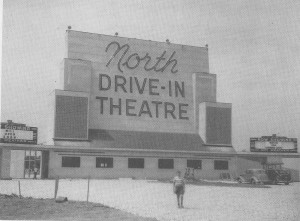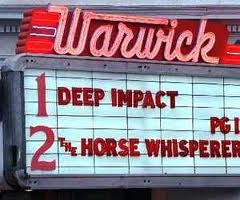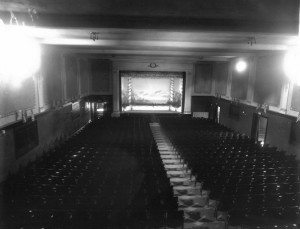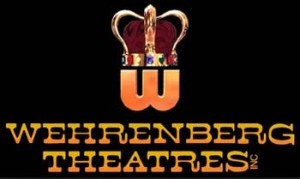I never felt so out of place, even in my own skin, as I did at age 43 in the first hours of my new job as an assistant manager at the Halls Ferry Six, one of the first multi-screen theaters in the St, Louis region. The lights were bright. The lobby was large, crowded and noisy. In a small cramped office behind the ticket booth, Randy, the young manager was explaining the inventory system for candy bars, popcorn bags and soda cups. I was dazed.
My previous job, preparing income taxes for a small St. Louis firm, had a familiar scholarly feel to it, with repeated calculations, research and paper forms but had ended for the season on April 15, 1982. Before that, I spent nine frustrating and fruitless months attempting to sell life insurance, my first stopgap attempt to support myself after losing my research position at Washington University school of Medicine in June 1980.
Near the end of the tax season, I responded to ad in the paper for a manager at a drive-in theater, The North Twin, in St. Louis County. I found David, the manager, a slender blond man in his mid-thirties painting the women’s room in preparation of the upcoming season. He explained that Wehrenberg was looking for some new assistant managers and that the work could be at his drive-in or in a conventional indoor theater. A few days later, I got the call to report to the Halls Ferry Six.
The theater was in a modest shopping mall at the northeast corner of New Halls Ferry and Dunn roads, just off Interstate 270 in an unincorporated area of North St. Louis County. Other mall occupants included a Target store, several smaller shops and a Wendy’s where we got takeout lunch once in a while. (Unlike the neat offerings from Burger King, McDonald’s and Hardee’s, the Wendy’s burgers were drenched in a viscous dressing that splattered all over if you didn’t eat them with great caution.)
Now in my third temporary job, at the movie theater, I would have few comfortable clerical tasks. Instead, I would be supervising a large number of high school students who worked part time as ushers and concession attendants, dealing with fellow managers and union projectionists and interacting with the public. What’s more, that public might be difficult; the theater was located in an area with a crime rate well above average, as I learned from the off-duty St. Louis County policeman who Wehrenberg hired to watch over the crowd on weekend evenings. “We don’t go into that apartment complex behind the theater without backup,” he said.
Across from the office was the large concession stand which featured soda, popcorn and the usual movie theater candy: Kit Kats®, Junior Mints®, Milk Duds®, Raisinets®, Twizzlers® and Reese’s Pieces® (for the 1982 movie E.T. the Extraterrestrial in which the candy played a large product placement role.) The closer you got the concession stand, the more it smelled of buttered popcorn. (it wasn’t real butter but a vegetable oil doctored up to taste like it.)
Behind the counter was a storeroom for the popcorn and other goods. Wide corridors on each side led to three auditoriums each. A door in one of the corridors led upstairs to the projection booths. The projectionists belonged to Local 143 of the Motion Picture and Projecting Machine Operators. Their contract forbade theater managers from entering the booths or handling film, except in situations like drive-ins, where it was a long walk from the delivery points to the booth. Then, according to one of the operators, it was not in their contract to carry the heavy film cans so far. In spite of this exception, most were decent men. The manager at the drive-in where the projectionist refused to carry film got his comeback when the St. Louis Cardinals played the Milwaukee Braves in 1982 World Series. The operator wanted to bring a television set into the booth and manager said that TVs in the booth weren’t in the contract either.

The North Twin Drive-In where I interviewed for my job for Wehrenberg Theaters in April 1982. Photo from “100 Years of Reel Entertainment,” the 2006 history of the Wehrenberg theater chain.
The chain was founded in 1906 when Fred Wehrenberg converted a vacant bakery in St. Louis into a nickelodeon to draw customers for his saloon and sandwich business. From that beginning he and his descendants built several more theaters in St. Louis and expanded beyond the city limits to build drive-ins in the 1940s and 50s. The family followed with multiplex cinemas in St. Louis County and beyond. All of this history with many delightful photos and movie business insights has been chronicled by Steven DeBellis in 100 Years of Reel Entertainment: How Wehrenberg Theaters Became the Longest Running Picture Show in America
I learned the mechanics of running the theater in a couple of weeks. I could stock and inventory the concession stand, run the registers and sell tickets and popcorn, help maintain the work schedule for the teen agers, make up the weekly payroll, and balance the nightly and weekly inventories.
After the last show ended, we counted all the cash, prepared deposit slips, double checked our figures, and summoned the armed guard waiting outside in his car. After we locked the theater, he followed one of us to the bank where we placed the canvas bags in the night depository.
My workday started at four in the afternoon when another manager and I arrived, an hour before opening. Our major task was to stock and inventory the concession stand including the heated popcorn dispensers. It wasn’t popped on-site. Instead, it came from a central facility run by the theater chain and was delivered to us a couple of times a week in large plastic bags 25-50 at a time depending on the expected crowd. We hoped that the phone wouldn’t ring to interrupt our opening preparations.
When it did, it was usually one of our high school employees: “Hi, Mr. Crowley, I can’t make it in today. I have a big algebra test tomorrow and need to study. You could call Lisa. Maybe she could fill in.” Since most of the kids were grateful for extra hours, it was usually easy to find replacements at the last minute. Besides, in a pinch, two managers and the projectionists could run the theater if the crowd was light, as it often was.

The Warwick Theater in Marblehead, MA in March, 1999, several years after its conversion to twin screens.
The early 1980’s were difficult times for many people for whom a night at the movies became unaffordable. At one point, in July 1982, attendance dropped to a level where my job at the Halls Ferry Theater was cut back to quarter time, placing even more of a financial strain on me than before. At home in my little apartment in University City, I was coping with calls from creditors and for a while was unable to pay my rent. After two or three weeks at quarter time, the crowds returned and I received more hours. My landlady helped too, by granting me loans to cover my back rent.
At first, movie theater employment seemed beneath a person with my education, but the truth was that I loved working at the Halls Ferry Eight. (Two screens were added a couple of months after I started.) When it was crowded and busy, I filled in by selling tickets or soda and popcorn. I came to life and gathered energy from the people and all the activity around me. And, I loved watching movies, as I often did, during the long intervals between the breaks in shows. I saw E.T. and Sophie’s Choice dozens of times.
In fact, I dreamed about the movie theater that I frequented as a child, the Warwick, in Marblehead, Massachusetts, where I grew up. In the dream, which occurred several times, the Warwick was huge with many auditoriums in addition to the one I remembered from childhood. The extra auditoriums were offset at different levels and angles from other parts of the theater and were seldom used. The seats in the sprawling dark auditoriums were dusty, and sunlight filtered in though the open back doors.

The Warwick Theater showing the single auditorium as it appeared when I was a kid. Photo courtesy of Dan Dixey’s “Historic Marblehead Images.”
The recurrent dream prompted me to call Tom McNulty, a slender bearded man about my age and height and the third generation owner of the Warwick, during a visit to my parents in Marblehead. “Sure, I’ll be glad to give you a tour,” he told me when he learned that I managed a cinema. Tom showed me all around the theater, including the vacant apartment off the projection booth on the second floor, where his grandparents had lived after opening the theater in the 1920s. They had named the Marblehead theater for Robert Warwick, a popular silent film actor of the day.
Next time: Wherenberg 2 – At Risk

